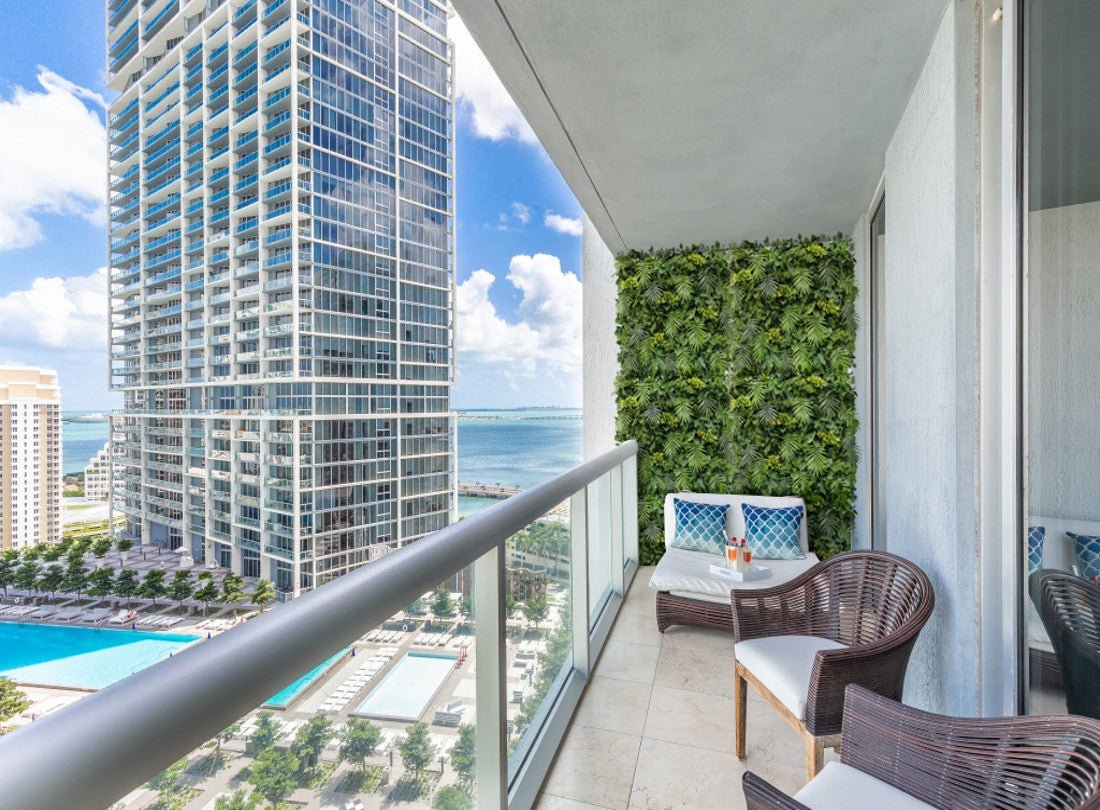Living on the edge of the coast in the US?
It turns out that almost 40% of the US population lives in coastal areas, although such regions account for less than 10% of the total land in the country.
If you’re one of the people living it up in the coastal US, you might be dealing with problems your compatriots in the Midwest aren’t, including heat, high humidity, and plants dying.
While many types of greenery have become accustomed to the (often harsh) weather conditions, this still limits your creativity and restricts what you can use to decorate your outdoor space.
But if you’re willing to experiment, we may have a solution - coastal fake plants, or more specifically, coastal artificial green walls.
What’s special about these decor options, you wonder?
Let’s talk about it below.
Are Artificial Green Walls Suitable for Coastal Regions?
Short answer - yes. Long answer - yes, with some precautions that won’t take more than a few minutes.
Artificial green walls are an excellent choice for coastal regions because they’re made of durable materials, primarily plastics, whose main trait is resilience.
As a result, Designer Plants faux vertical gardens can deal with unpredictable weather often present in coastal regions, as they’ve done so previously and are made to be sturdy.
We’ve tested our products in coastal regions across the world and noted how they perform so that we share relevant advice to maintain them for years. Our faux green walls have found homes in a few beach-front properties and poolsides, where they get all the sun and salt one could only dream of.
Artificial green walls are ideal for adding a pop of greenery to spaces that celebrate the sun and sea, without hassling you for constant maintenance.
Thanks to the blend of durable materials used during manufacturing, an artificial green wall from a reputable supplier will stand the test of time if it’s cared for the right way.
But what is the right way?
Maintenance Tips for Artificial Green Walls in Coastal Regions
If you’re interested in purchasing artificial greenery for your coastal property, you need to consider some things.
While they don’t require nearly as much maintenance, you should still pay attention to them. We promise it won’t take more than a few minutes a month.
Here are 5 easy maintenance tips for your coastal artificial green wall:
1. Clean it regularly

Most of the maintenance you’ll have to do with artificial plants is cleaning them once every few months to prevent dust and debris from accumulating on the leaves. To do this, you’ll need:
- A microfiber cloth
- A sponge
- Lukewarm water
- A hairdryer
- A feather duster
If you notice a coat of dust, blow it away with a hairdryer or dust it off with a feather duster. Once the loose debris falls off, spray your faux green wall with a showerhead or dip a sponge in water and go over the panels.
Then, take your microfiber cloth and dry the panels to ensure no water drips from the leaves. If you want more comprehensive cleaning instructions, check out our cleaning guide.
2. Make sure it’s UV-resistant

Since you live in some of the sunniest areas in the US, you'll need to pay attention to the type of vertical garden you buy.
Before purchasing, always make sure the panel you're buying is UV-resistant and can withstand exposure to the sun. These UV-resistant properties set high-quality faux green walls apart from low-quality ones.
Plus, this built-in protection means your green wall won't fade, discolor, or deteriorate prematurely.
If you've already bought a green wall that's not UV-resistant, get a UV spray to provide similar protection. Once you spray it, it will have a bluish color, but it will become translucent after a few minutes.
3. Rince salt residue

Living on a coast means salt. Everywhere.
Due to the fine mist of sea spray carried inland by the wind, salt residue may be a common issue for all your outdoor decor, including your artificial garden panels.
Over time, salt residue can accumulate on surfaces (and leaves), which may lead to dullness and discoloration, as the panels would be covered with a coat of salt. If you notice this happening, use a garden hose to gently rinse the faux vertical garden wall with fresh water.
For harder-to-reach spots, use a pressure washer on a low setting. Do this at least monthly, depending on how fast salt accumulates on the panel.
After heavy storms or high winds, inspect your panel for increased salt deposits and rinse them off as needed to prevent long-term buildup.
4. Keep it dry
Faux green walls look fabulous on beachside properties or poolsides. Yet, it’s important to keep in mind that, while these types of fauxliege can withstand various weather conditions, they should be dry most of the day.
If you regularly splash your panels while swimming or if they soldier through storms and winds, take some time to dry the leaves to keep them looking their best.
To do this, use the same microfiber cloth we mentioned above. Or, use a hairdryer on a cool setting.
5. Inspect for wear and tear
Don’t skip quality checks, especially if you’ve had your artificial vertical garden for a while.
Continued use and exposure to all the elements can change the structural integrity and appearance of all outside decor, including green walls. Of course, a good-quality product won’t break down, especially if it’s under a warranty, but it might show signs of wear and tear.
Once every few months, inspect your panels meticulously for any bent leaves and branches, tears, or other issues. Address these promptly by fluffing up the foliage to adjust the position of the leaves and determine what caused the problems.
Why UV-Resistant Green Walls Matter for Coastal Living
Out of all the tips we’ve mentioned here, UV resistance is the most important one for coastal properties with relentless sun. Here’s why it’s imperative for your panel:
- Protects against fading: Sunlight can wreak havoc on outdoor decor, especially if you don’t protect it. Without proper UV protection, your faux green wall will fade and discolor (and look fake). But, if you get a green wall with UV inhibitors, they’ll maintain their vibrancy even after prolonged exposure to direct sunlight.
- Extended longevity: Sun damage affects appearance and weakens materials over time, leading to brittle leaves or cracking. UV resistance, if applied, can help the panels withstand the elements and ensure durability for years.
- Perfect for every spot: You can place your faux green wall in direct sunlight by the pool, on a shaded patio, or covering a sunny beachfront facade without worrying if it lasts. By having UV protection, your panels will stay lush and vibrant wherever they are.
What Are the Benefits of Artificial Green Walls for Coastal Areas?
Coastal living comes with unique challenges like salty air, high humidity, and lots of sunshine. Luckily, faux green walls are designed to thrive in these conditions.
As we said, there are many benefits to this investment, including:
- No water requirements: Since artificial green walls are, well, artificial, they don’t need any watering. So, you don’t need to think about the water bill or schedule time out of your day to water your plants.
- Don’t attract bugs: Coastal fake plants don’t release any substances into the air to attract pollinators and other insects. This means you won’t be swarmed by mosquitoes every time you come near the fauxliege.
- Don’t fade: If your outdoor artificial green walls are UV-resistant (and they should be), they won’t fade, deteriorate, or discolor soon. If you get a product with a warranty, you’ll be sure it will last for years.
- Come with warranties: You can stay protected from liability and ensure you’re buying a faux green wall that’s built to last. Our faux green walls can last 5 years and beyond outdoors, provided they’re UV resistant. Keep in mind that warranties don’t cover extreme weather conditions like hail or floods, so read before you buy.
- Easy to install: You don’t need a crew of professional builders and installers to come in and hang up your faux green wall. Since they’re DIY-friendly, you can install them yourself following our instructions and have one more project you can brag about.
Finishing Thoughts
Maintaining artificial green walls in coastal regions doesn’t take much effort, but it does require some background knowledge.
By following the advice in this blog, you can effectively keep your faux vertical garden in great shape without dedicating hours of your time.
If you’d like some help with inspiration or want to use green walls on your coastal property, reach out to us and we’ll give you a laundry list of ideas on how to do so.


